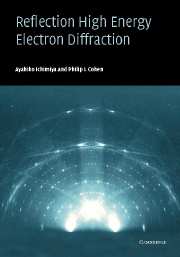Book contents
- Frontmatter
- Contents
- Preface
- 1 Introduction
- 2 Historical survey
- 3 Instrumentation
- 4 Wave properties of electrons
- 5 The diffraction conditions
- 6 Geometrical features of the pattern
- 7 Kikuchi and resonance patterns
- 8 Real diffraction patterns
- 9 Electron scattering by atoms
- 10 Kinematic electron diffraction
- 11 Fourier components of the crystal potential
- 12 Dynamical theory – transfer matrix method
- 13 Dynamical theory – embedded R-matrix method
- 14 Dynamical theory – integral method
- 15 Structural analysis of crystal surfaces
- 16 Inelastic scattering in a crystal
- 17 Weakly disordered surfaces
- 18 Strongly disordered surfaces
- 19 RHEED intensity oscillations
- Appendix A: Fourier representations
- Appendix B: Green's functions
- Appendix C: Kirchhoff's diffraction theory
- Appendix D: A simple eigenvalue problem
- Appendix E: Waller and Hartree equation
- Appendix F: Optimization of dynamical calculation
- Appendix G: Scattering factor
- References
- Index
15 - Structural analysis of crystal surfaces
Published online by Cambridge University Press: 06 July 2010
- Frontmatter
- Contents
- Preface
- 1 Introduction
- 2 Historical survey
- 3 Instrumentation
- 4 Wave properties of electrons
- 5 The diffraction conditions
- 6 Geometrical features of the pattern
- 7 Kikuchi and resonance patterns
- 8 Real diffraction patterns
- 9 Electron scattering by atoms
- 10 Kinematic electron diffraction
- 11 Fourier components of the crystal potential
- 12 Dynamical theory – transfer matrix method
- 13 Dynamical theory – embedded R-matrix method
- 14 Dynamical theory – integral method
- 15 Structural analysis of crystal surfaces
- 16 Inelastic scattering in a crystal
- 17 Weakly disordered surfaces
- 18 Strongly disordered surfaces
- 19 RHEED intensity oscillations
- Appendix A: Fourier representations
- Appendix B: Green's functions
- Appendix C: Kirchhoff's diffraction theory
- Appendix D: A simple eigenvalue problem
- Appendix E: Waller and Hartree equation
- Appendix F: Optimization of dynamical calculation
- Appendix G: Scattering factor
- References
- Index
Summary
Introduction
In order to determine the atomic positions of atoms in the first few surface layers, the RHEED intensity must be measured as a function of the scattering angles and then compared with dynamical calculations. There are two methods, which are the intensity rocking curve method (Maksym, 1985; Ichimiya et al., 1993b for example) and the azimuthal plot method (Mitura and Maksym, 1993). In the rocking curve method, diffraction intensities along several reciprocal rods are measured as functions of the incident angle of the electron beam. For azimuthal plots, one measures the specular intensity as a function of azimuth from a given direction of the incident and beam and at a given incident angle. For both methods, integrated intensities are measured in order to reduce the morphological effects of the surfaces (Ichimiya, 1987a; Appendix C). These two methods are equivalent and just involve different methods of collecting the data. In either case a model of the surface structure must be assumed for comparison with the measurement. Convergent-beam RHEED uses a combination of both methods (Ichimiya et al., 1980; Smith, 1992; Smith et al., 1992). In this case the incident beam is not parallel but cone-like, as shown in Fig. 7.11. Dynamical analyses of the relative intensities of different RHEED spots also give knowledge of surface structures (Hashizume et al., 1994). In this chapter we will examine a particularly useful method of comparing dynamical calculations with measured rocking curves.
- Type
- Chapter
- Information
- Reflection High-Energy Electron Diffraction , pp. 195 - 210Publisher: Cambridge University PressPrint publication year: 2004

